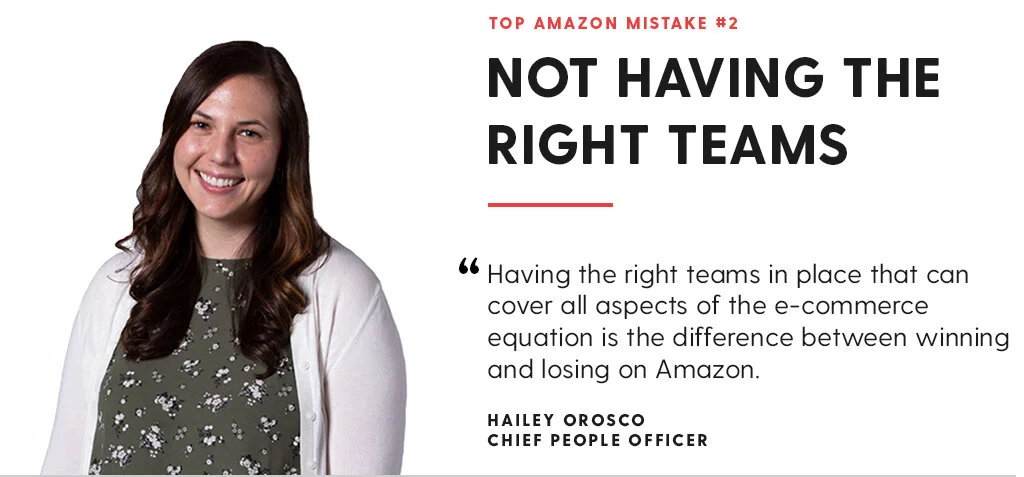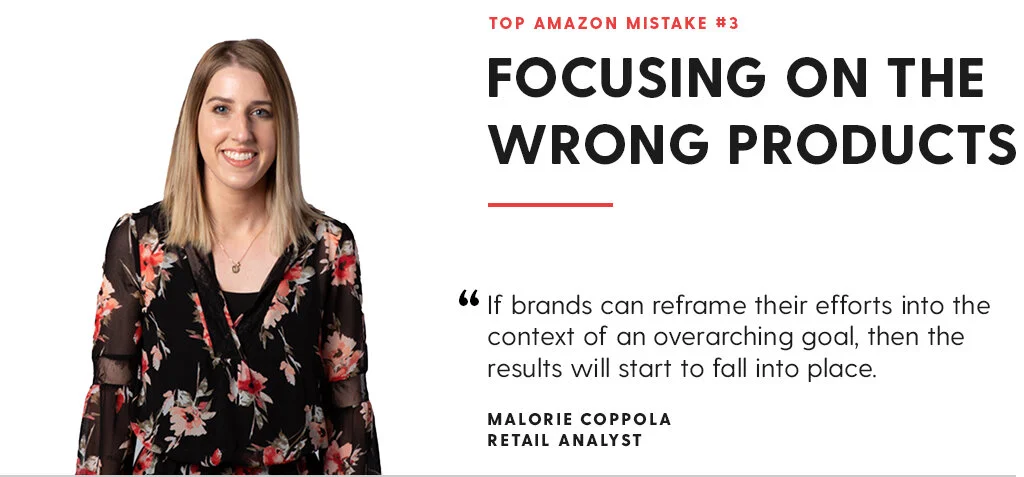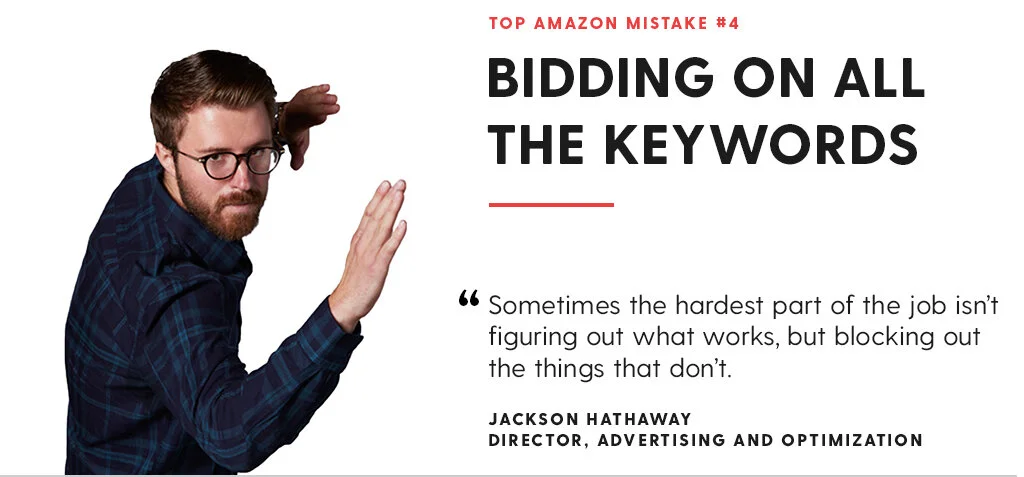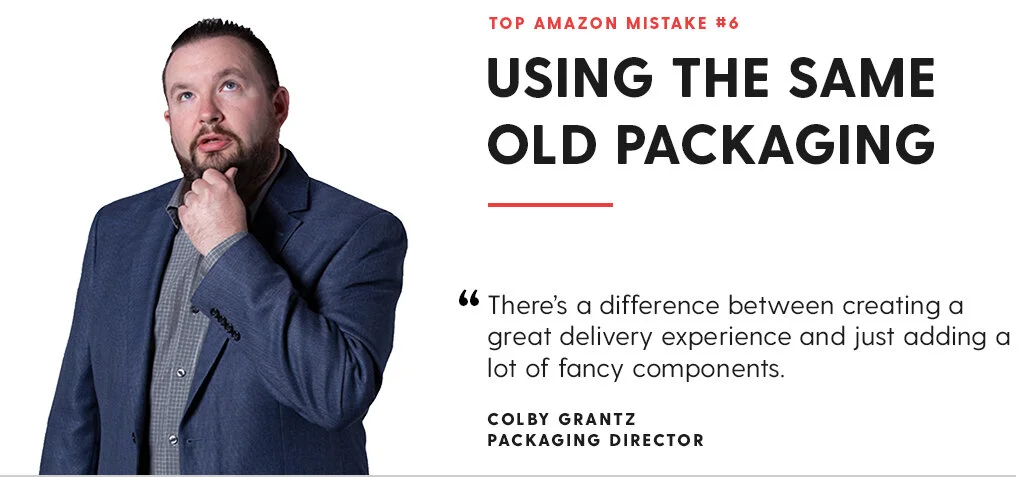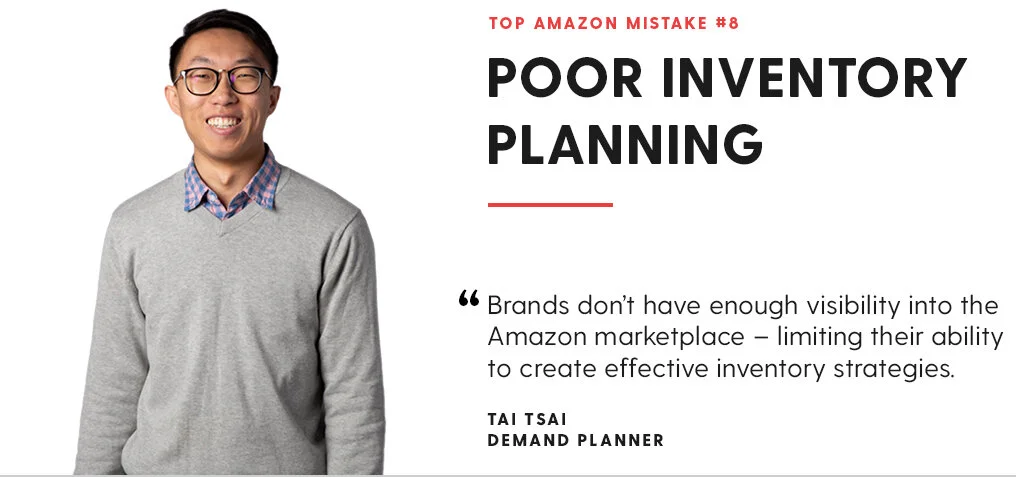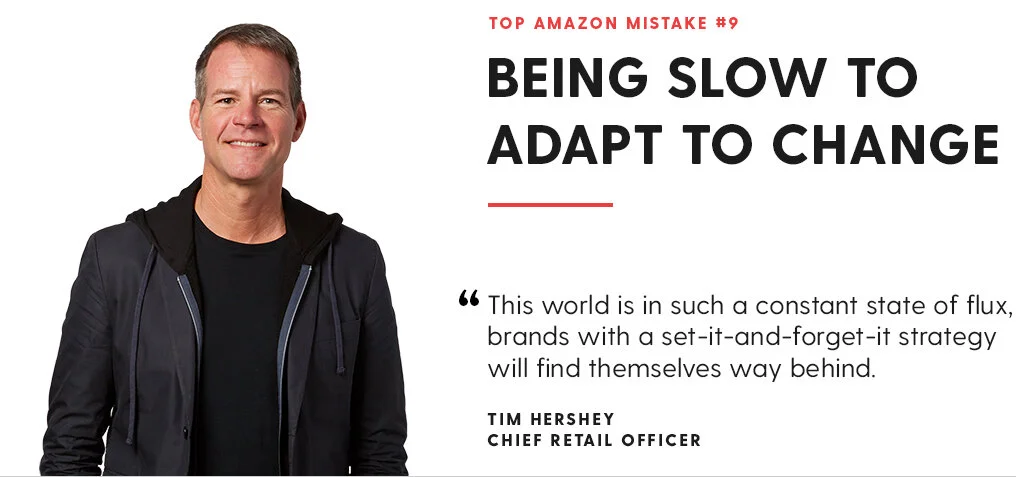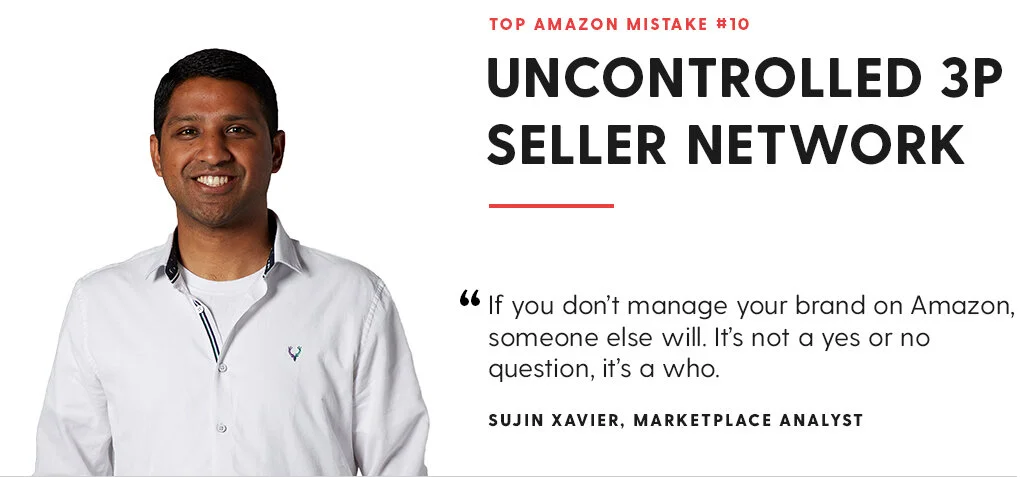Top 10 Amazon Mistakes Brands Make
Amazon is its own retail universe apart from the rest of e-commerce. Because of that, it doesn’t easily marry with traditional retail strategies. Marketing, packaging, merchandising — all of these things need to be navigated in a way that’s very specific to the Amazon marketplace.
There are lots of ways to do things right on the marketplace, but there are also lots of ways to do things wrong. Here are the top 10 mistakes brands make on Amazon.
Ignoring Amazon Altogether
47% — you probably already know where we’re going with this. It’s a stat most brands have become very familiar with. It’s a number that’s been cited in hundreds of articles across the interwebs to herald Amazon’s position as the industry leader in e-commerce. In case you’re still not sure what we’re talking about, it’s the share of e-commerce sales Amazon took in 2020.
Like it or not, Amazon is a massive part of the e-commerce industry, and retail as a whole. A massive amount of people love shopping on Amazon, and if you’re a brand, your customers are also Amazon customers. By ignoring the marketplace, you’re choosing not to meet your customers where they are.
Instead of ignoring Amazon, brands should create a channel strategy that recognizes Amazon as a key component.
A large percentage of every brand’s audience is shopping on Amazon. If you’re not on Amazon, how are you going to serve your consumers that are?
Raj Sapru - Chief Operating Officer
Not Having the Right Teams in Place
For sizable brands, Amazon is no longer something that can (or should) be handled by a single appointed “Amazon person” on staff.
Properly maintaining an Amazon presence is a huge undertaking. There are multiple aspects of the marketplace that require constant attention: catalog maintenance, customer service, content creation, Amazon-specific marketing campaigns, e-commerce-ready packaging, demand planning, and so much more.
In this day and age, Amazon should no longer be thought of as a backburner sales channel, but rather a significant revenue driver, a discovery platform, and a necessity to keep brand integrity in check. Your success on Amazon is directly correlated to the amount of resources you invest in the marketplace.
Effective allocation of resources is everything. Having the right teams in place that can cover all aspects of the e-commerce equation is the difference between winning and losing on Amazon.
Hailey Orosco - Chief People Officer
Focusing on the Wrong Products
Not every product is a great fit for a marketplace like Amazon. While it is okay to add everything to the marketplace, brands should focus their attention on products that make the most sense. There are key things brands should consider before investing in a product's Amazon performance.
Margins are slimmer. Because of this, products with low price points may be challenging on Amazon. Shipping costs — especially considering Amazon’s 2-day or 1-day push — can make low price point products unprofitable and unsustainable.
Categories can be crowded. Despite what some YouTube ad gurus might tell you, Amazon isn’t a great place to bandwagon. If a category is crowded with sellers and products, it’s not a great idea to jump in without a strategy or comprehensive product launch plan.
Customers are different. Shoppers behave differently on Amazon than they do in physical stores. Before a brand invests in a product’s Amazon performance, they should take the time to research their audience on the digital marketplace.More than anything, it’s important that brands have a strategy before they start selling on the marketplace. Understanding how Amazon fits into an overall retail strategy informs where a brand should focus their efforts.
The goal is almost never to simply sell more units. If brands can reframe their efforts into the context of an overarching goal, then the results will start to fall into place.
Malorie Coppola - Retail Analyst
Bidding on All the Keywords
Amazon advertising is a constant balancing act, especially with keyword advertising. There are an infinite number of keyword combinations brands can choose from. It’s easy to get caught up in a competitive mindset and bid on too many keywords.
Finding keywords that work is only half the battle. An equally important part of Amazon advertising is identifying the keywords that don’t work.
Sometimes the hardest part of the job isn't in figuring out what works, but in blocking out the things that don't, or what we refer to as ‘negative search term targeting.’ The most common mistake an inexperienced marketer might make is to take all of the good traffic on a keyword without removing all of the traffic that is intended for a different kind of product.
Jackson Hathaway - Director, Advertising & Optimization
Catalog Disorganization
Scattered and disorganized product catalogs set customers up for a frustration-filled shopping experience. There are many ways catalogs can fall into disorder, but one of the most common is when multiple listings get created for the same product.
Ideally, each product should only have a single listing. This isn’t easy to accomplish on Amazon. The presence of third-party sellers means that it’s possible for anyone to create a one-off listing, which can quickly fragment a brand’s catalog.
Keeping a catalog organized and consolidated requires daily maintenance and effort. Having a team dedicated to solving catalog problems — creating, maintaining, and organizing listings — is the best way to ensure everything stays in order.
We see a lot of catalogs that have each individual option on it's own detail page, which makes it difficult for a customer to find. A business is less likely to get a sale if a customer has to search tirelessly for the variation and size they have in mind. If all variations and size options for a given model are on one page the sale is more likely to happen.
James Lopez - Catalog Manager
Using the Same Packaging as Brick & Mortar
E-commerce has completely different packaging needs than brick and mortar. When it comes to package design, there needs to be a focus on both supply chain and the customer experience.
Using packaging that’s designed to look good on a physical shelf may be gratuitous for the purposes of e-commerce. Instead of focusing on visual bells and whistles, brands should thoughtfully design packaging specifically with supply chain and e-commerce in mind.
Luxury e-commerce packaging is almost always over-packaged or embellished since these products have a wow factor as part of their luxury status. The packaging leads you through an experience of presenting the product. But there’s a difference between creating a great delivery experience and just adding a lot of fancy components.
Colby Grantz - Packaging Director
Letting Amazon “Handle” Customer Service for You
A brand is only as strong as its customer service. On Amazon, customer service translates into responding to reviews, being flexible with returns, answering questions for the Q&A section, and promptly getting back to customer inquiries.
Brands that neglect customer service will experience more dissatisfied customers, poor product reviews, and higher return rates. Instead of ignoring customer experience on Amazon, brands should invest in a solid customer service strategy that accounts for the unique needs of Amazon shoppers.
I think the biggest mistake is assuming that your Amazon customer will be the same as your DTC customer — have the same knowledge, interest and buying habits.
Andrea Ten Kley - Customer Experience Manager
To learn more about reviews, read The Ultimate Guide to Amazon Product Reviews.
Poor Inventory Planning
There’s a delicate balance between overspending on storage fees and being out of stock at the wrong times. Brands historically have had a difficult time maximizing efficiency when it comes to demand planning on Amazon — and fees are only going up. This is especially true for companies that are heavily influenced by seasonality.
The main thing is that brands don’t have enough visibility into the Amazon marketplace — limiting their ability to create effective inventory strategies.
Tai Tsai - Demand Planner
Being Slow to Adapt to Change
As far as strategy goes, e-commerce is a moving target, especially when it comes to Amazon. A new advertising feature might launch, Amazon’s core policies might shift, or the search algorithm might change.
Change happens, and it happens often. Brands that have agile teams, a close connection with their distribution partners, and are tapped into the constant changes of the e-commerce world come out on top.
There’s no such thing as 'done' in e-comm. This world is in such a constant state of flux, brands with a set-it-and-forget-it strategy will find themselves way behind. Be nimble, listen to what your shoppers are telling you, and adapt.
Tim Hershey - Chief Retail Officer
Allowing an Uncontrolled 3rd Party Seller Network
For most brands, it’s not if they’re on Amazon, it’s how they’re on Amazon. Anyone with a garage full of product can start an Amazon account and start selling. If you’re a brand with an open distribution network, chances are your products are already being sold on the marketplace by sellers you aren’t familiar with.
Unlike traditional retailers, sellers on Amazon aren’t obligated to follow standards brands have come to expect — including minimum advertised pricing (MAP) policies or marketing guidelines. If left unchecked, an uncontrolled distribution network can lead to drastic price differences between brick and mortar and e-commerce. This puts enormous pressure on physical retailers and can erode a brand’s retail relationships.
To prevent this, brands need to gain a full picture of their distribution network and take steps to protect their brand on Amazon.
If you don’t manage your brand on Amazon, someone else will. It’s an open marketplace, and there’s plenty of opportunity for a third-party to sell your brand’s product. It’s not a yes or no question, it’s a who. Sujin Xavier - Marketplace Analyst
————
Learn more about how Netrush helps brands succeed on Amazon



